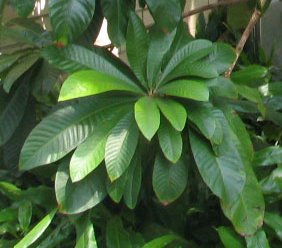
Acanthaceae is a family of dicotyledonous flowering plants containing almost 250 genera and about 2500 species. Most are tropical herbs, shrubs, or twining vines; some are epiphytes. Only a few species are distributed in temperate regions. The four main centres of distribution are Indonesia and Malaysia, Africa, Brazil, and Central America. Representatives of the family can be found in nearly every habitat, including dense or open forests, scrublands, wet fields and valleys, sea coast and marine areas, swamps, and mangrove forests.

The Sapotaceae are a family of flowering plants belonging to the order Ericales. The family includes about 800 species of evergreen trees and shrubs in around 65 genera. Their distribution is pantropical.
Phelline is a genus of shrubs and the sole member of the family Phellinaceae, a family of flowering plants endemic to New Caledonia. It is placed in the order Asterales and is related to two other small plant families: Alseuosmiaceae and Argophyllaceae. It contains ten species.

Ricinodendreae is a tribe of the subfamily Crotonoideae, under the family Euphorbiaceae. It comprises 3 genera.

Pouteria is a genus of flowering trees in the gutta-percha family, Sapotaceae. The genus is widespread throughout the tropical Americas, with outlier species in Cameroon and Malesia. It includes the canistel, the mamey sapote, and the lucuma. Commonly, this genus is known as pouteria trees, or in some cases, eggfruits.

Dombeya is a flowering plant genus. Traditionally included in the family Sterculiaceae, it is included in the expanded Malvaceae in the APG and most subsequent systematics. These plants are known by a number of vernacular names which sometimes, misleadingly, allude to the superficial similarity of flowering Dombeya to pears or hydrangeas. Therefore, the genus as a whole is often simply called dombeyas. The generic name commemorates Joseph Dombey (1742–1794), a French botanist and explorer in South America, involved in the notorious "Dombey affair", embroiling scientists and governments of France, Spain, and Britain for more than two years.

Anisophyllea is a genus of plant in the family Anisophylleaceae. The generic name is from the Greek meaning "unequal leaf", referring to the dimorphism of the leaves.

Olax is a plant genus in the family Olacaceae. The name derives from the Latin, olax (malodorous), and refers to the unpleasant scent of some of the Olax species. Olax is an Old World genus represented by several climbers, some species have leaves and fruits smelling of garlic such as Olax subscorpioidea and Olax gambecola, seeds of the latter are used as condiments in parts of West Africa. In India Olax nana is well known as one of the first species to emerge after forest fires, the shoots growing directly from buried roots.

Polysphaeria is a genus of plants in the family Rubiaceae, and its native range is Madagascar and Tropical Africa. It contains the following 22 species according to Plants of the World Online:

Parsonsia is a genus of woody vines in the family Apocynaceae. Species occur throughout Indomalaya, Australasia and Melanesia.

Griffonia is a genus of central African flowering plants in the legume family, Fabaceae. It belongs to the subfamily Cercidoideae. Griffonia is known to have a high concentration of 5-HTP in its seeds.

Mundulea is a genus of flowering plants in the family Fabaceae. It includes 12 species of small trees and shrubs native to sub-Saharan Africa, Madagascar, and India. It belongs to the subfamily Faboideae.

Planchonella is a genus of flowering trees in the gutta-percha family, Sapotaceae. Named in honour of Jules Émile Planchon, it was described by Jean Baptiste Louis Pierre. It contains around 110 mainly tropical species, which range from Pakistan through Southeast Asia and New Guinea to northern and eastern Australia, New Zealand, and the Pacific Islands. The genus is included in the larger genus Pouteria by some authorities, hence species such as Planchonella australis are also known as Pouteria australis.
Christian Leberecht von Prøck (1718-1780) was a Danish baron. He served as Governor-General of the Danish West Indies colonies from 1756–1766. In 1768, Pröck became a diocese commander over Iceland and the Faroe Islands. He died on 4 September 1780 in Copenhagen. The plant genus Prockia is named after him.
Coelospermum is a genus of flowering plants in the family Rubiaceae. The natural range of the genus is parts of southern China, Malesia, Papuasia, Australia and New Caledonia.
Telectadium is a genus of flowering plants belonging to the family Apocynaceae.
Paropsia is a genus of flowering plants belonging to the family Passifloraceae.

Rhodocolea is a genus of flowering plants belonging to the family Bignoniaceae.

Zanthoxyloideae is a subfamily of the family Rutaceae.














